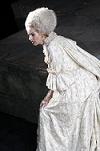The late announcement of a change in the musical and artistic direction at the Nice Opera ultimately disrupted the logic of the schedule: Puccini’s “Manon Lescaut” opened the 2009/2010 season and left an impression of a false start, a beginning that wasn’t one. Indeed, it was the last production at the Saint-François-de-Paule Establishment by the former director and producer Paul-Emile Fourny. A subdued start despite the collaboration with the Puccini Festival in Torre del Lago. Certainly, France has always been musically dismissive of this Puccini work, created in Turin in 1893, believing that after Jules Massenet’s “Manon,” performed at the Opéra Comique nine years earlier, the Italian composer had not genuinely innovated. This perspective risks displeasing our Italian friends, for whom “Manon Lescaut,” Puccini’s third opera, marks the first triumph of the master from Lucca.
For this first performance at the Nice Opera, the Orchestra was conducted by Alberto Veronesi, a specialist of this repertoire: a brilliant student of the Giuseppe Verdi Conservatory, where he obtained his diplomas in piano, composition, and orchestral conducting, he was appointed artistic and musical director of the Fondazione Festival Puccini in Torre del Lago in 1999. The cast was enticing: the soprano Amarilli Nizza, who comes from a family that has been devoted to music for four generations, is a diva in Italy. Some of her compatriots had even traveled to hear her. They certainly would not have been disappointed by her voice, which had been described as very beautiful. It was not an unwarranted claim. A timbre of rare clarity, easy and pleasant high notes, and an exceptional vocal technique that allows her to sustain notes for what seems like eternity, whether projected or subdued. Yet, despite a surname that encourages leniency, Amarilli Nizza disappoints with her stage performance: her expressions are often mismatched to the scene she is portraying (does a woman consumed by love to the point of death in the final act constantly tuck a stray blonde lock behind her ear like a mere schoolgirl?). Furthermore, she seems out of sync with her body, moving with little grace on stage. It is a real mystery that unfortunately mars the credibility of her emotions. Physically more comfortable in his skin, the tenor from Hong Kong who performs beside her struggles with his voice: he must exert considerable energy to hit the high notes. The Nice baritone Jean-Luc Ballestra almost seems to lecture him. We should note the promising talents of Stanislas de Barbeyrac for the future.
For his final production, expectations were that Paul-Emile Fourny would exit Nice with flair or even provocation: this was not the case. Classicism prevails. A classicism that involves positioning the artists in the middle of the stage during their vocal performance, during which everything else seems to stop. A single set, barely altered by a few panels and lighting effects, ultimately goes unnoticed in front of costumes fortunately more sophisticated, especially those that dress—or undress—the ballet corps of the Nice Opera, whose excellent artistic performance must be commended here. Despite small joys, here and there, in this production, this season’s start felt more like the end of an era.


